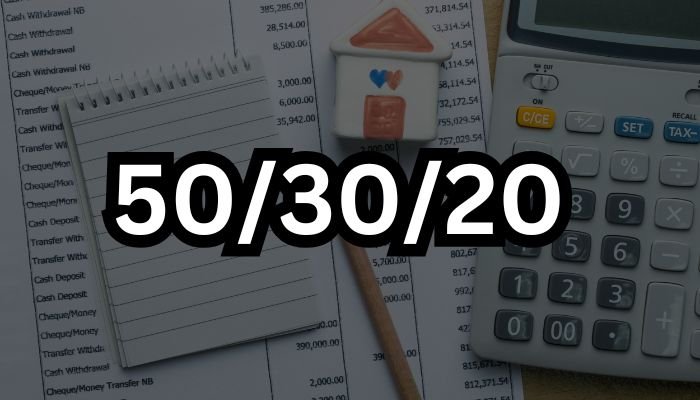Disclaimer: This post may contain affiliate links, meaning we get a small commission if you make a purchase through our link at no extra cost to you. For more information, please visit our Disclaimer Page.
Managing money can feel like an overwhelming task, especially when it comes to balancing your needs, wants, and savings.
One budgeting method that has gained immense popularity for its simplicity and effectiveness is the 50/30/20 budget.
This approach helps individuals manage their expenses and savings by allocating a set percentage of income to different areas of life: 50% for needs, 30% for wants, and 20% for savings or debt repayment.
In this guide, we will delve into all aspects of the 50/30/20 budget—its definition, functionality, and ways to incorporate it into your daily routine.
What is the 50/30/20 Budget and How Does it Work?
The 50/30/20 budget is a straightforward financial planning tool that divides your after-tax income into three categories:
- 50% for Needs: These are the essentials—expenses like rent, utilities, food, transportation, and insurance that you cannot avoid.
- 30% for Desires: This part includes non-essential items. These are desires, not necessities, that you seek. They include dining out, fun activities, trips, and memberships..
- 20% for Savings/Debt Repayment: This part is for building your savings or paying off debts. This includes student loans, credit card bills, or adding to a retirement fund.
This simple yet powerful formula makes it easy to control your spending and put money toward your financial goals.
It works because it’s easy to follow and doesn’t require complicated calculations or spreadsheets.
It aims to provide a balanced way to support financial stability and personal enjoyment.

How to Create a 50/30/20 Budget: Step-by-Step Guide
Creating a 50/30/20 budget may seem daunting at first, but with the right steps, it can become second nature.
Here’s a guide to help you get started:
- Determine Your After-Tax Income: To begin, find your total after-tax monthly income. This includes your salary, any freelance or side income, and other sources of income. If you’re unsure of your after-tax income, check your pay stub or tax returns to calculate it.
- Calculate Your Needs: Once you know your income, allocate 50% to cover all essential expenses. This will cover rent or mortgage, utilities, groceries, transportation, health insurance, and other essential daily expenses.
- Plan for Your Wants: Next, set aside 30% of your income for non-essential spending. This is the place to enjoy spending your money—be it on dining, entertainment, or traveling experiences.
- Save or Pay Off Debt: Lastly, allocate 20% to savings or debt repayment. You might need to add to your emergency savings. You can also contribute to retirement plans like a 401(k) or IRA. Another option is to reduce student loans or credit card debt.
After you set your budget, use tools to track your spending. These tools help you watch your spending and ensure you follow the 50/30/20 rule.
Adjust your allocations as needed based on changes in income or expenses.
50/30/20 Budget for Different Audiences: Families, Students, and Millennials
The 50/30/20 budget is not the same for everyone. It can be modified to suit various requirements. If you are a student, a millennial, or a parent, you can adjust this budget to match your lifestyle.
50/30/20 Budget for Families
Families usually spend more money because of kids, mortgage payments, and other home costs.
The 50/30/20 budget helps families manage their money. It keeps them organized and prevents overspending on non-essential items.
By setting clear boundaries, families can prioritize savings for emergencies and future goals like college tuition or retirement.
50/30/20 Budget for Millennials
Millennials often face the challenge of balancing student debt with the desire to build a stable financial future.
The 50/30/20 budget helps millennials allocate funds to savings and debt repayment.
By following the formula, it is easier to stay focused on paying off debt while still enjoying life.
50/30/20 Budget for Students
For students, managing finances on a limited budget can be tricky.
The 50/30/20 budget is ideal for students because it provides a simple breakdown of how to spend their limited income.
By focusing on important expenses first, like tuition and living costs, students can save a little for the future. This helps them avoid stress about money.
50/30/20 Budget for Beginners: Key Considerations
If you’re new to budgeting, the 50/30/20 budget is a great starting point. However, there are some things to keep in mind:
- Track Your Spending: Before jumping into budgeting, take a month to track your spending. Applications like Mint or YNAB assist in monitoring your expenditure patterns.
- Avoid Lifestyle Inflation: As your income increases, it’s tempting to upgrade your lifestyle. Stick to your 50/30/20 plan and increase savings instead.
- Check Your Budget Often: Your budget might need changes as things change, so check it often.
The Benefits of the 50/30/20 Budget: Why It’s Effective
The 50/30/20 budget has gained popularity due to its simplicity and effectiveness. Here’s why it works:
- Simplicity: It’s easy to understand and follow, making it perfect for beginners.
- Flexibility: You can adjust the percentages to fit your financial situation, making it suitable for everyone.
- Balanced Approach: It ensures you don’t overspend on luxuries while still prioritizing savings.
Can the 50/30/20 Budget Help You Pay Off Debt?
Yes! The 50/30/20 budget can help you pay off debt by prioritizing debt repayment with the 20% savings allocation.
If it’s credit card debt, student loans, or medical bills, consistently applying the 50/30/20 formula can help you balance savings with debt reduction.
50/30/20 Budget Tools and Apps to Simplify Your Finances
There are several tools and apps designed to help you follow the 50/30/20 budget. These resources make it easier to track your income, expenses, and savings goals.
- Mint: A free app that tracks your expenses, sets budgets, and provides insights into your spending patterns. Start using Mint.
- YNAB (You Need a Budget): A popular app that helps you assign every dollar a job. It’s designed to work with the 50/30/20 budget to ensure you stay on track. Check out YNAB.
- PocketGuard: A budgeting app that shows how much disposable income you have left after accounting for bills and savings goals. Download PocketGuard.
50/30/20 Budget Template: Excel vs Google Sheets
When it comes to managing your 50/30/20 budget, Excel can help you stay organized: Excel Google sheets.
Using the Best 50/30/20 Budget Calculator Excel Free template
How to Use the 50/30/20 Budget Calculator Template
To start using the 50/30/20 Budget Calculator Template,
- Simply click the provided link, then select “Make a Copy.”
- This will save the template to your Google Drive, allowing you to edit it freely.
- Once copied, you can personalize the template by entering your income and expenses under the designated categories:
Needs (50%), Wants (30%), and Saving (20%).
The built-in formulas will automatically calculate percentages and totals, giving you a clear overview of your budget.
Why This Template Will Simplify Your Finances
This user-friendly template is designed to make budgeting effortless.
By simply plugging in your income and expenses, the percentages will adjust in real-time, helping you visualize how your money is allocated.
It’s fully customizable, so you can experiment with different numbers to see how adjustments impact your budget.
Achieving financial goals has never been easier!
Common Mistakes to Avoid with the 50/30/20 Budget
While the 50/30/20 budget is simple, many people make mistakes along the way. Here are some common errors to avoid:
- Not Tracking Expenses: It’s easy to overspend if you don’t track your expenses regularly.
- Ignoring Debt Repayment: Don’t neglect the 20% savings portion. If you have debt, ensure a portion of this goes toward paying it off.
- Lifestyle Creep: As your income increases, resist the urge to spend more on “wants” and stick to your budget.
Conclusion
The 50/30/20 budget is a straightforward and effective way to manage your finances.
if you’re new to budgeting or looking to improve your current strategy, this method can help you stay on track with your goals and improve your financial health.
By prioritizing your needs, saving for the future, and enjoying life’s pleasures, you can achieve financial success.
Ready to take control of your finances and start budgeting today?
Use the tools and tips mentioned above to set up your 50/30/20 budget and start working toward your financial goals now!
I know this is a lot so save for later so you can always come back to it.





